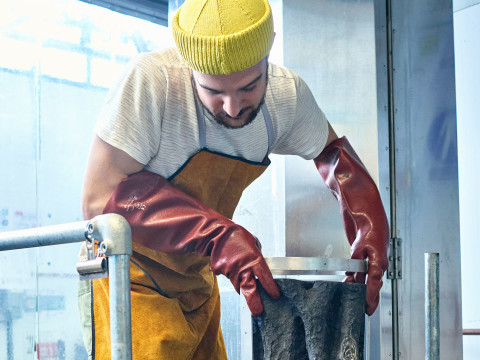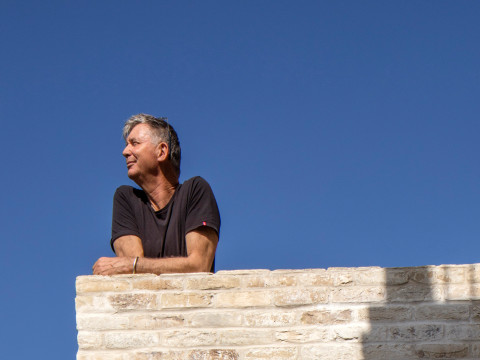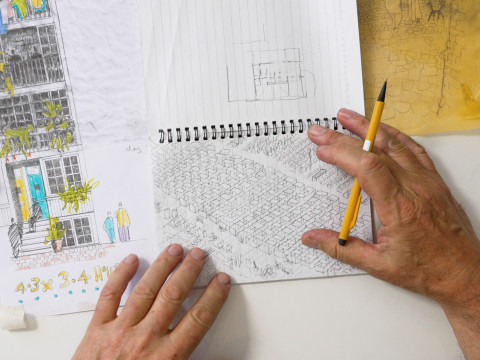
Six works to know by architecture duo Bruther
Published on 30 June 2022
In 2007 architects Stéphanie Bru and Alexandre Theriot combined their names to form Bruther – a studio dedicated to inventive, generous and socially engaged buildings. Before they give the Royal Academy's 31st Annual Architecture Lecture this month, get to know their work here.

1. Pelleport social housing, Paris
2009–2016
Tucked away in an unusual and challenging site between existing buildings, this block of flats is the result of Bruther’s first architectural design competition win in 2009, only a year after the practice was founded. The building faced opposition in the neighbourhood at first, with nearby residents launching legal objections against the plan to accommodate low-income and formerly unhoused people – meaning the project wasn’t completed until 2016.
Despite these challenges, the pair have remained committed to socially engaged work in the peripheries of cities, where they describe finding “fertile ground to be ‘architects’ and ‘citizens’ together: here, architecture can redefine the imperatives of housing quality, as the heritage of all; here, architecture can direct new attentions and responsibilities.”

2. Saint-Blaise Cultural and Sports Center, Paris
2010–2014
Saint-Blaise is one of the most densely populated neighbourhoods in Europe. In response to this, Bruther’s cultural centre aspires to provide the residents with much-needed services, including youth activities, music classes, a gym, and even space to develop circus performances – all stacked vertically to maximise the surrounding public square.
A resident from the surrounding area writes that the building “fills the void that reigns in the heart of what is an extremely dense neighbourhood, while simultaneously establishing and organising an entire life around it that, until now, had fled this environment. … Its unusual architecture encourages it to be used in unexpected ways.”

3. Rehabilitation and expansion of a high-rise building, Paris
2015–2018
Tasked with re-modelling an office block originally built in 1978, Bruther nestled a new five-storey extension underneath the existing structure, using fluid curves, transparent facades, and green public gardens to blend the rigid, lonely building into its surroundings.
A key element of most Bruther projects is their permeability and the opportunities this creates for space – they often choose to lift their structures off the ground, leaving the ground level open for public use. This approach does not come without difficulties: while they carefully created space below these offices, it’s since been fenced off in the name of security.
Some details from Bruther projects

Bruther Architects, Paris, France

Bruther Architects, Paris, France

Bruther Architects, Caen, France

Bruther Architects, Paris, France

4. Student residence and reversible car park, Palaiseau
2020
This U-shaped building currently houses four floors of light-filled student accommodation, plus large spaces for collective activities, and nearly 500 car parking spaces – but its design means these allocations can be easily adjusted depending on what the neighbourhood needs in the future. For example, the car park area could become extra accommodation, or house community facilities, and the courtyard layout is intended to provide space for another architect to add a structure if requirements change.
Through painstakingly considering the entire lifespan of a building, including any potential revisions, the pair create sustainable designs where longevity and flexibility offset the initial impact of construction.

5. New Generation Research Center, Caen
2013–2015
Bruther playfully refers to this project as the Swiss Army knife of buildings: it fulfils multiple functions within a rational and compact space.
There’s a public plaza, an exhibition space, a conference area, a bar, manufacturing workshops, a start-up space, and a rooftop event space – with each flowing into one another. Temporary partitions can be added and removed to introduce new configurations and create new spaces. The pair describe their design approach for buildings like this as “working on the cohabitation of differences”.

6. Residence for University Researchers “Maison Julie-Victoire Daubié”, Paris
2014–2018
The commitment to ample space at the heart of Bruther’s work is apparent in these residences for postgraduate students.
Despite its location on a small plot next to a ring road, the building's layout has been optimised to house spacious studio rooms with sliding partitions that can be adjusted according to their inhabitants’ needs. But here the architects have gone beyond minimum standards and considered what makes spaces genuinely liveable, generating opportunities for meeting, socialising, working out in the rooftop gym – or just enjoying the view of the city.

The 31st Annual Architecture Lecture
Bruther founders Stéphanie Bru and Alexandre Theriot will be exploring their commitment to flexible public buildings and the principles that drive their influential practice.
Related articles

Crunch: inside the first Architecture Window display
14 February 2024

RA Architecture Prize Winner 2023: Shane de Blacam
1 September 2023

Introducing Bêka & Lemoine
9 August 2023

In the studio: Peter Barber RA
27 July 2023

